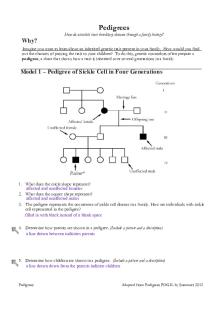2-6 Pedigree Analysis - Professor Kelson PDF

| Title | 2-6 Pedigree Analysis - Professor Kelson |
|---|---|
| Course | Dna: Genetic Identity, Disease And Design |
| Institution | Brigham Young University-Idaho |
| Pages | 2 |
| File Size | 115.9 KB |
| File Type | |
| Total Downloads | 52 |
| Total Views | 136 |
Summary
Professor Kelson...
Description
1. Why is pedigree analysis used in determining the mode of inheritance for human genetic disorders, instead of looking at specific crosses? Pedigrees are a more accurate way of recording someone’s risk for disease. It is less probability and more practical. It helps identify those that are at risk. They are able to figure out the method of transmission through pedigrees. 2. What is a proband? A proband is a member of the family that brought a potential genetic issue to the attention to a healthcare professional. 3. Explain what is meant by each of the following symbols in a pedigree: a. Open circle An unaffected female b. Solid square An affected male c. A circle or square with a diagonal line drawn through it Deceased d. A vertical line connecting a square and a circle Line of decent (father to daughter) 4. An individual in a pedigree is designated as III-4. What does this mean? Third generation (child), and the 4 is just the number they are assigned. 5. List the five primary modes of inheritance of human genetic disease. Autosomal dominant, autosomal recessive, X-linked dominant, X-linked recessive, and mitochondrial. 6. The proband is a woman who is affected. Neither her husband nor her only sibling, an older brother is affected. The proband has five children by her current husband. The oldest is a boy, followed by a girl, then another boy, and then identical twin girls. All of the children are affected except for the second oldest son. Both of the parents of the proband show the trait. a. Using the above information construct a pedigree, then determine how this trait is inherited. Pedigree on next page, probably autosomal dominant 7. Paul and Diana have seven children. Two boys and two girls have four of the same medical problems - obesity, deafness, loss of central vision, and diabetes mellitus. Paul has a brother Ralph, married to Alice, and they have two daughters. Diana has a sister, Wendy, married to Joe, and they have three boys, Tom, Steve, and Russ. Paul’s parents are Michael and Sandra; Diana’s parents are Frank and Bertha. Frank is Michael’s brother. Paul and Diana’s family doctor thinks that the four children with the symptoms - George, John, Becky, and Tabitha - have a genetic disorder called Alstrom syndrome. a. Using the above information construct a pedigree. Next page b. Determine the most probable mode of inheritance for this inherited disorder. Autosomal recessive
I
II
III
I I I
II I...
Similar Free PDFs

Pedigree Analysis worksheet 1
- 6 Pages

Pedigree analysis worksheet
- 1 Pages

KELSON THEORY
- 23 Pages

Pedigree Trait identification
- 3 Pages

Pedigree worksheet answers
- 2 Pages

Pedigree Chart Worksheet
- 1 Pages

Pedigree AND Genealogy
- 8 Pages

Pedigree Charts - Ueueufjur
- 1 Pages

Pedigree worksheet Answer KEY
- 1 Pages

pedigree pogil activity real 1
- 7 Pages

Chapter 26 - Lecture notes 26
- 5 Pages

TEMA 26 bioquimica - Apuntes 26
- 1 Pages
Popular Institutions
- Tinajero National High School - Annex
- Politeknik Caltex Riau
- Yokohama City University
- SGT University
- University of Al-Qadisiyah
- Divine Word College of Vigan
- Techniek College Rotterdam
- Universidade de Santiago
- Universiti Teknologi MARA Cawangan Johor Kampus Pasir Gudang
- Poltekkes Kemenkes Yogyakarta
- Baguio City National High School
- Colegio san marcos
- preparatoria uno
- Centro de Bachillerato Tecnológico Industrial y de Servicios No. 107
- Dalian Maritime University
- Quang Trung Secondary School
- Colegio Tecnológico en Informática
- Corporación Regional de Educación Superior
- Grupo CEDVA
- Dar Al Uloom University
- Centro de Estudios Preuniversitarios de la Universidad Nacional de Ingeniería
- 上智大学
- Aakash International School, Nuna Majara
- San Felipe Neri Catholic School
- Kang Chiao International School - New Taipei City
- Misamis Occidental National High School
- Institución Educativa Escuela Normal Juan Ladrilleros
- Kolehiyo ng Pantukan
- Batanes State College
- Instituto Continental
- Sekolah Menengah Kejuruan Kesehatan Kaltara (Tarakan)
- Colegio de La Inmaculada Concepcion - Cebu



